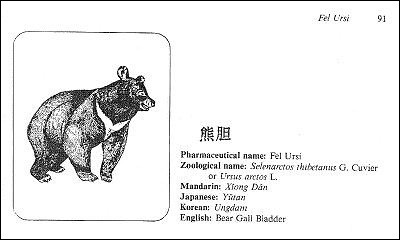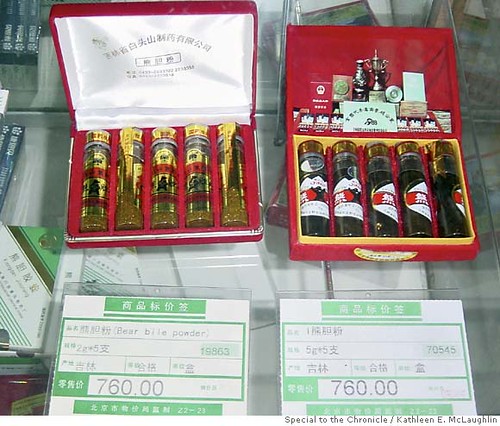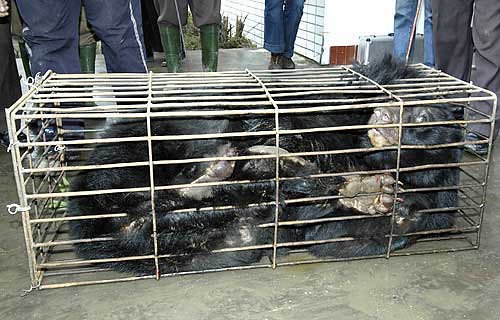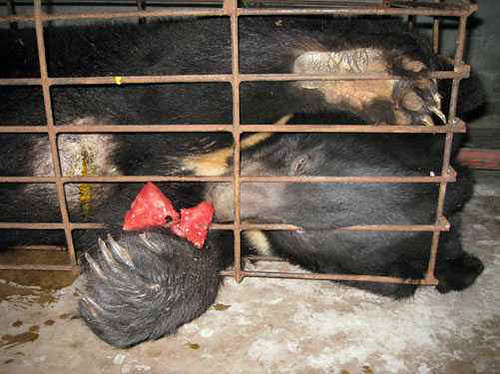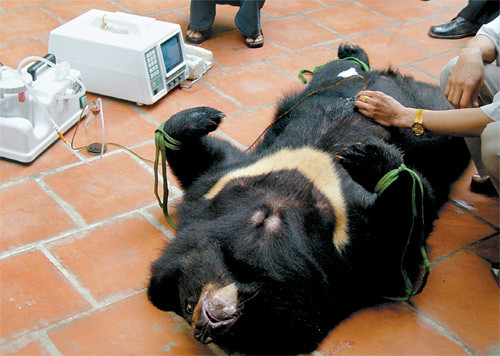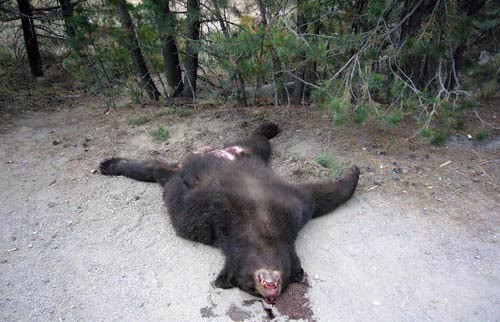Imagine living 20 years spending 24 hours a day in a cage that tightly fits your body, not giving you room to stand up, stretch out, turn around, or move at all.
Imagine that twice a day during these years you would have a metal catheter inserted into a hole which has been cut into your abdomen, allowing the catheter to easily puncture your gall bladder, or maybe a long syringe inserted into your gall bladder, piercing through your skin again and again, by people who are not doctors.
Imagine becoming infected and cancerous because of this twice-daily physical invasion, and becoming neurotic due to your claustrophobic imprisonment.
Imagine having one or both of your hands cut off so someone can sell them for a lot of money.
Imagine you begin to chew at your hands, if you are lucky enough to have one or both left, due to your developing neuroticism, and to distract yourself from the pain you experience twice a day, every day, for your entire life.
This is reality for an estimated minimum of 12,000 bears across Asia.
— Sara Pegarella, JD
Currently, animal activists across China are up in arms because Gui Zhen Tang Pharmaceutical Corporation, a Fujian-based company that sells bear bile for use in Traditional Chinese Medicine (TCM), has tried to increase production through an initial public offering (IPO). The company is being accused of cruelty towards animals in the process of extracting their bile at an industrial scale. Bear bile, or Xiong Dan (熊胆), is an important ingredient in TCM.
The issue is not new: since the early 2000s, animal activists have circulated hundreds of shocking articles, images, and videos that recount unimaginable cruelty towards caged bears in Asia. The practice has even outraged celebrities, such as Jackie Chan, who have pleaded with consumers to stop buying products made from bears and other endangered species. But now it’s all over the news. Gui Zhen Tang’s IPO has met with fierce public opposition, and has once again led environmentalists to appeal against the cruelty of live bear bile extraction.
As this documentary shows, bear bile is sold throughout Asia for a variety of conditions. The Chinese Herbal Medicine: Materia Medica (1986) by Dan Bensky, Andrew Gamble, and Ted Kaptchuk lists bear bile as a remedy for trauma, sprains, fractures, hemorrhoids, conjunctivitis, severe hepatitis, high fever, convulsions, and delirium. The Materia Medica also states that “because of the high price of bear bile (Xiong Dan), often cow bile, Fei Bovus (Niu Dan), is substituted at a higher dose.”1 There is no mention, however, of the horrific means by which the animal bile is obtained. The guide also lists other animal products (rhinoceros horn, tiger bones, deer musk, and bat and squirrel feces [sic]) used as medicine.
Image 1. The bear bile entry in the 1986 version of Materia Medica by Bensky et al. The entry in the latest edition (3rd ed. 2004) has been moved to “Obsolete Substances.” Image used with the explicit permission of Eastland Press.
The globalization of TCM has lead to a dramatic increase in the demand for bear bile along with other traditional remedies. Bear bile is sold in Asian apothecaries throughout the world in the form of powder, solution or pills. It is likewise the key ingredient in many Asian “patent medicines” used for tapeworm, childhood nutritional impairment, hangovers, colds, and even cancer. Bear bile is even found in Chinese throat lozenges, shampoo, wine, and tea.
Image 2. Raw bear bile in both liquid and powder forms. Photo: Kathleen E. McLaughlin, the Chronicle Foreign Service correspondent in Beijing
Overall, the worldwide trade in bear parts, including bile, is estimated to be a $2 billion industry. Research in August 2007 by the animal rights group Animals Asia shows its staggering profitability: while the wholesale price of bile powder is around US$410 per kg in China, the retail price increases exponentially to 25 to 50 fold in South Korea, and to 80 fold in Japan (US$33,000 per kg)!
While the trade in bear products is prohibited under the Convention on International Trade in Endangered Species (CITES), and the importation and trade of bear bile products to North America is illegal under both US and Canadian law, many products are still openly offered for sale in Chinese stores. Back in 2001, when the World Society for the Protection of Animals conducted a probe of Asian shops in Canada and four US cities — Chicago, New York, Washington, and San Francisco — it found that 91% of the shops surveyed sold some form of bear part, including farmed bile powder, bile medicines, and whole gallbladders, which the merchants claimed originated from wild bears in China. When WildAid, an animal rights group based in San Francisco, sent an undercover investigator into Chinatown in 2004, two shopkeepers readily produced vials in velvet-lined boxes with pictures of a bears on the lid.
Bear bile is obtained through surgically implanting a tube in the animal, in a process called “milking,” that produces an average 15 ml (.5 oz) of bile each time. The Humane Society of the United States reports that the process of milking is so painful for the bears that they moan and often chew their paws during the procedure. In order to make access to the animals easier, the farmers often break the bears’ teeth and pull out their claws, sometimes brutally removing whole digits. If the bears stop producing bile, they are left to die, or are killed for their gallbladder and paws (considered a delicacy in China).
According to Jeanette McDermott, the founder of Ursa Freedom Project, bear farming in Asia increased during the 1980s in response to the dwindling supply of bear parts obtained from bears hunted in the wild. Tragically, the situation grew out of control, and by the early 1990s, there were over 400 bear farms in operation, containing more that 10,000 bears. Plans were in place to increase the number of bears in farms to 40,000 by the year 2000.
Today, China produces 7,000 kilos of bear bile annually, much of which is illegally exported to Japan, Korea, Australia, Canada, and the US. Whole bear gallbladders are also exported: the Humane Society of the United States says smugglers have been caught with gallbladders packed in coffee to conceal their smell, or dipped in chocolate to disguise them as chocolate-covered figs.
Most of the bears used in bile farming are Himalayan black bears (Ursus thibetanus), also known as “Asiatic black bears” or “Moon bears,” due to the cream-colored crescent moon shape on their chests. As their population has decreased by almost 40 percent over the past few decades, they have been listed (since 2000) as among the most critically endangered species on the International Union on Conservation of Nature’s Red List of Threatened Species.
A number of the bears in bile farms are captured illegally in the wild as cubs. Poachers either wait to capture new-born cubs until the mother leaves the den in search of food , or sometimes they simply kill her to get to the babies. Some of the cubs are born in captivity — but in either case, bear cubs rarely survive to adulthood — and those who do often grow into the bars of their cages as their bodies mature.
Image 3. Is this traditional medicine or savagery and barbarism? Photo: Cornelius Maarselar/Animals Asia
Animal activists posing as potential clients report that the caged bears moan, writhe in pain, and clutch their stomachs as the bile drains from their bodies. Sometimes the bears try to pull out the catheters. Those that succeed are immobilized in an iron corset. Under-nourished and highly stressed from horrific pain and unnatural confinement, the bears lie in agony, in their own filth.
According to Jeanette McDermott, bile is not the farmers’ only source of profit from the bears. Some farmers amputate one or two paws from live bears to sell to restaurants. When bears are no longer able to secrete bile, they are left to die from sickness or starvation. Bears might endure this torture for up to 25 years, making their lifetime a reality of suffering and pain in the name of “natural” and “traditional” medicine.

Image 4. This metal clamp is placed around bears who might struggle or move around excessively in order to ensure they remain still through the painful bile extraction. Photo: Animals Asia
There are a number of extremely painful techniques used for milking bear bile. Image 4, above, illustrates the common extraction technique that relies on plastic or metal catheters, and often necessitates a metal jacket in order to restrain the bears (the chilling details can be found at the Animals Asia website). Some farms rely on an ultrasound machine to guide a catheter connected to a medicinal pump. In this method, the bears are sedated — usually with ketamine — restrained with ropes, and have their abdomens jabbed repeatedly with four-inch needles until the gallbladder is located. Animals Asia suspects that this process leads to dangerous leakages of bile into the body, and to a slow and agonizing death from peritonitis.
In recent years, China has introduced a new, “humane,” free-dripping extraction method, which does away with the need for catheters. Free-dripping involves carving a permanent hole, or fistula, into the bear’s abdomen and gall bladder, from which bile drips out freely. The damage caused by the bile’s leaking back into the abdomen, together with infection from the permanently open puncture, is even worse than the catheters method, and results in a high mortality rate. Often, the bears’ livers and gallbladders become severely diseased through this process, and the collected bile is contaminated with pus, blood, urine and feces.
Image 5. Sometimes a hollow steel stick is pushed through the bear’s abdomen, and the bile runs into a basin under the cage. In this case, about half of the bears die from infections or other complications. Photo: Animals Asia
Image 6. Ultrasound bile extraction from a bear in Vietnam. Photo: Asia Wild Life
A healthy bear’s bile is as fluid as water, and ranges in color from bright yellow-orange to green. However, Animals Asia’s vets have described bile leaking from the gallbladders of farmed bears as “black sludge.” Eminent Chinese and Vietnamese pathologists have warned the public not to use bile taken from sick bears.
The active substance in bile (of bear and all other mammals) is ursodeoxycholic acid (UDCA), also known as Ursodiol, which is easily synthesized, and has been available for several decades. It is estimated that 100,000 kilos of synthetic UDCA are already being used each year in China, Japan, and South Korea, and that the total world consumption may double this figure.
Despite the availability and affordability of synthetic UDCA and suitable herbal alternatives, some practitioners obstinately continue to prescribe bear bile, which in turn drives up the market demand, and pressures the Chinese government to continue to allow the practice of bear farming.
The world’s appetite for bear bile and other parts has also led to the hunting and killing of wild bears in the North America. The media reports that the poaching of bear gallbladder for its use in TCM is on the rise in the US. The Los Angles Times, of August 22, 2008, writes that Fish and Game Wardens in California (CA) often report finding dead black bear carcasses that have been skinned and dismembered. The gallbladder is by far the most often stolen part (see the Los Angeles Times of November 29, 2010). The CA animal safety group, BEAR League, reports that since the beginning of 2007, as many as 87 dead bears have been found near state roadsides. On occasion, they report the bears’ heads or paws are cut off, but they also report finding bear carcasses with the gallbladder missing.
Image 7. This California black bear was struck and killed on State Highway 89 near Lake Tahoe in August 2008. State wildlife officials say the gallbladder was removed. Photo: BEAR League
The appalling impact of TCM on endangered species goes well beyond bears though. It affects the world’s most precious and protected animals, such as Bengal tigers, American bears and African rhinos. A worldwide interest in alternative medicine and the ease of international commerce now put dozens of species worldwide at risk. And while most of traditional Chinese medicines rely on herbs, the demand for products made at the expense of threatened animals continues to grow. In reality, many of the current claims associated with the medicinal value of animal products are spurious; but reality hasn’t stopped the rising demand for these illegal substances, and the profits to be made by poachers and smugglers rise.2
While the use of some animal products was perhaps justifiable in the past — when there were no alternatives available, the extent of demand was limited, and the particular species were plentiful in their natural habitat — it is no longer sustainable, or justifiable, given our modern, globalized, and technically-advanced world. Today, with other approved therapeutic alternatives available, there is little justification for the use of endangered species such as the black bear.3
The belief advanced by the Counterculture of the 1960s and the New Age movement — that “natural” curatives are better than their synthetic equivalents — contributes enormously to TCM’s popularity in North America today. These groups originally objected to the growing over-consumption and over-reliance on synthetically-produced medicines, over natural alternatives. And while these concerns should be considered serious, the apologists of TCM and other types of traditional medicines fail to recognize that at present, their massive demand for “natural” products has made crime against animals commonplace. TCM has behind it a powerful, moneyed group of consumers whose “needs” now drive a whole black market economy — one that supports poachers, bear bile farmers, and all types of heinous torture.
As I wrote his article, I was overwhelmed with rage, and repulsed not only by the horrific images of the animal holocaust in Asia, but also by the enormous hypocrisy of the proponents of TCM, who effectively claim that pus-infested bear bile, and the by-products of animals tortured, disfigured, and dismembered in the name of the“natural” are better, safer, and “gentler” than synthetic pharmaceuticals.
With many thanks to Sara Pegarella, JD, and Kristin Koster, PhD, for their valuable comments.
The above mentioned animal rights advocacy groups (Animals Asia, Asia Wild Life, etc.) were not interviewed for this piece and any information attributable to them was taken from their websites. I encourage you to visit these sites to become more informed and involved.
REFERENCES
- Bensky D, Gamble A, Kaptchuck T. Chinese Herbal Medicine: Materia Medica. Revised Edition. Eastland Press. 1986. Return to text
- Ellis R. Tiger Bone & Rhino Horn: The Destruction of Wildlife for Traditional Chinese Medicine. Island Press; 1 edition. 2005. Return to text
- Still J. Use of animal products in traditional Chinese medicine: environmental impact and health hazards. Complement Ther Med. 2003 Jun;11(2):118-22. Return to text

